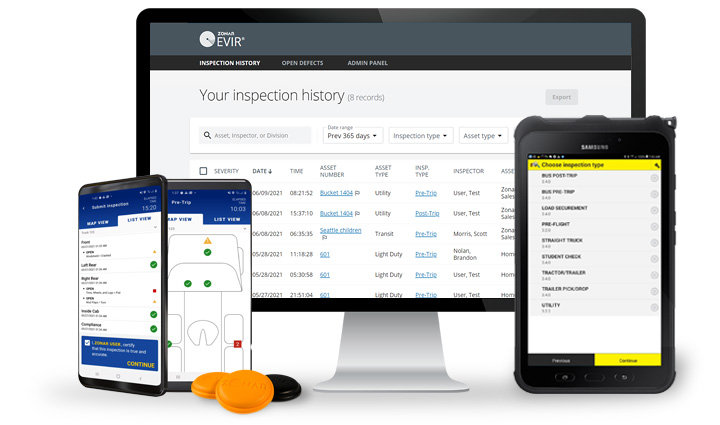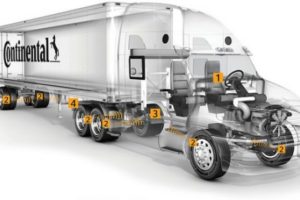In any given year, there may be more than half a million crashes reported involving large trucks, according to the Federal Motor Carrier Safety Administration (FMCSA). In the most recent reporting period, the FMCSA reported 4,479 fatal crashes and 114,000 large truck accidents resulting in injuries.
Several studies cited by the Insurance Institute for Highway Safety (IIHS) analyzed large trucks involved in accidents and revealed that between 40% and 60% of the vehicles had at least one mechanical violation that contributed to the crash.
Pre- and post trip inspections and safety checks are an important part of every truck driver’s daily routine to keep their vehicles operating safely, avoid accidents, and comply with federal regulations.
Driver Vehicle Inspection Reports
At the end of each workday, a driver must prepare a driver vehicle inspection report (DVIR) and turn it into their home terminal. The drive must inspect both the power unit and trailer to identify any deficiencies, and they must then note these in the DVIR. If a driver flags problems, the carrier is required by law to repair defective or missing parts and accessories before allowing the vehicle to be driven.
The motor carrier or its agent must also certify in writing that the necessary repairs have been made and the defects have been corrected.
DVIRs are required under FMCSA codes in sections §396.11 and §396.13.
DVIR is the paperwork drivers file when performing their mandatory inspections. There are also electronic versions of the form called eDVIRs which make filing and tracking easier. With an eDVIR, drivers can submit results immediately after completing the inspection.
Both ways of filing have their limitations, however.
With a DVIR, paperwork could easily get lost, misplaced, or damaged. Even diligent and reliable drivers can misplace a form or forget to file upon their return. Since maintenance issues often go unaddressed until the form is turned in, it is easy for maintenance issues to go unnoticed. An inefficient system can lead to significant safety problems.
An eDVIR system provides a much more efficient workflow. Inspection data is captured digitally and securely uploaded for review. This makes addressing and scheduling any necessary repairs simpler. Drivers can also attach photos to help pinpoint areas that need fixing.
However, in both cases, carriers and operators have to trust the drivers to do what is required rather than “pencil whipping” the form and approving it without actually inspecting the vehicle. If this happens, problems can go unnoticed and lead to safety issues.
Electronic Verified Inspection Reporting
Zonar EVIR® is the only patented electronic verified inspection report (EVIR) system. EVIR complies with all DOT, OSHA, MSHA, and PRASP regulations. Unlike DVIR and eDVIR solutions, Zonar EVIR inspections are truly verifiable.
It’s impossible to pencil whip EVIR inspections or rush through inspections and skip important steps.
When drivers skip steps, they may miss important safety problems that go unnoticed. Even if these problems don’t lead to accidents, they may be flagged during one of the 2.5 million roadside inspections done each year by law enforcement. The FMCSA estimates that such programs prevent 14,000 accidents and 9,000 injuries each year.
During these roadside inspections, more than 30% of vehicles inspected are put out of service. Inspectors record 3.9 million violations annually. That adds up quickly for motor carriers, who lose about $270 million in revenue each year due to violations, fines, and downtime from roadside inspections.
Many of these deficiencies could have been reported as having a clean bill of health by drivers using DVIR and eDVIR methods if drivers failed to physically inspect the vehicle. It’s too easy for a driver at the end of a long day to just sit in the cab and check the boxes on a report. EVIR forces the drivers to visit each zone and verifies that the inspection actually took place.
How Does Electronic Vehicle Inspection Reporting (EVIR) Work?
With EVIR, radio-frequency identification (RFID) or near field communication (NFC) tags are placed on the vehicle in inspection zones. These tags are digitally linked to the vehicle, which confirms the vehicle’s identity. Information is automatically loaded into the EVIR.
Drivers must physically visit each inspection zone and scan the RFID tag with their mobile device. They are unable to complete the form without visiting each zone. Because each entry is time-stamped, carriers will be able to tell if an inspection was rushed. They can track when inspections start, stop, and how long drivers spent in each zone.
For fleets that can’t use RFID tags, such as leased or rented equipment, drop and hook loads, or in the intermodal markets, drivers can also operate EVIR in tagless mode. Drivers follow the same procedures, upload the information via a secure portal, and electronically verify and certify inspection results.
In addition to ensuring proper pre- and post- trip inspections occur, an additional significant benefit of EVIR is that it helps create an electronic paper trail for auditing and notifications. Drivers can receive alerts when any needed repairs are completed and vehicles are ready to return to service. They can also access current and historical data for inspections and EVIR reports.
Smart Fleet Management Solutions
Zonar has a complete lineup of smart fleet management solutions, including Zonar EVIR® for pre- and post-trip inspections, Ground Traffic Control® fleet tracking software, ZFuelTM tracking for fuel efficiency, smart fleet management tablets, and more. These tools help keep fleet owners, managers, and dispatchers connected to their fleets and drivers.
To learn more about how smart fleet management solutions can streamline your operations, save you money, and improve your safety, contact the fleet management experts at ZONAR today.







